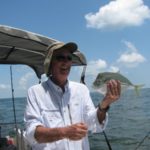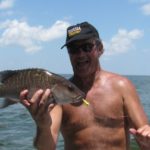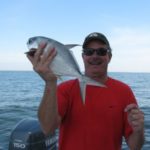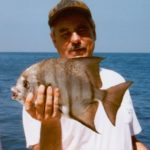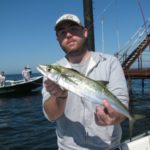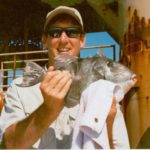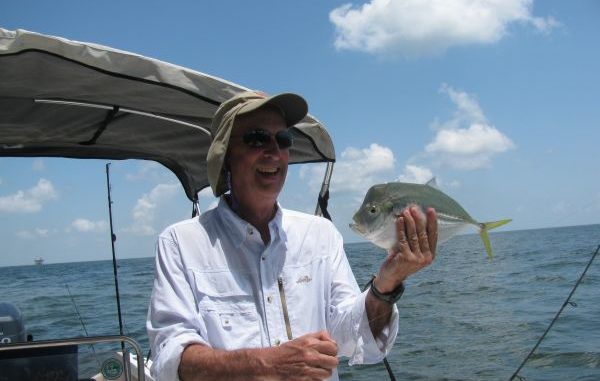
Why tough it out trying to catch a few trout around Grand Isle when you can head a few miles offshore and stock up on all sorts of fish for a camp cookout?
The horror finally became intolerable, and I creaked out of bed and limped out to the beach-front porch — to find that Pelayo and Eddie had beat me to it.
They looked morose, staring balefully at the small rollers lapping at the brownish sand. A calm Gulf stretched out behind the tiny waves to the rigs.
“A little cooler out here!” I said, trying to pep things up. “And fewer mosquitoes!”
They slowly looked up and….
Remember Dirty Harry? Remember his look before his famous line?
“Go ahead, make my day.“
Well, Pelayo and Eddie’s faces made Harry Callahan’s look like Mary Poppins’.
“What a weekend for the window unit to go out,” Eddie finally groaned while slowly wiping his brow with his sopping, filthy sleeve and scratching the red welts on his leg with the other hand.
“Knew we shoulda gone to Doc\’s place in Venice this week-end,” Pelayo snarled, and then went into a violent coughing-hacking fit. He finally spit, sighed wearily and began scratching his sweaty neck and arms. “These things never happen over there.”
“Oh, Mama,” I quickly smiled and sang. “Can this really be the end, To be stuck inside of Grand Isle, with the Venice blues again!”
Remember Charlton Heston in the original “Planet of the Apes?” Remember his famous? “Get your stinking paws off me you damn, dirty apes!“ Remember his face when he said it?
Well, Heston’s face made Pelayo and Eddie’s look like Jimmy Stewart and Donna Reed’s as they hugged at the end of “It’s a Wonderful Life.”
Broken air conditioners in a Louisiana August do that to people, especially after a sweltering and still night in a poorly-ventilated camp on Grand Isle. In desperation we opened all the windows, unaware that the holes in the 20-year-old screens made them as good a barrier against mosquitoes as a landing net.
I doubt any of us had actually slept for more than 10 minutes at a stretch — the mosquitoes constantly whining by our ears, biting our noses and foreheads, as we slapped and sweated.
Nobody smiled. Nobody was in the mood to hear my pathetic attempt at mirth. We all knew it would take a lot more than a Dylan tune to salvage this looming debacle of a weekend.
Putrid slime covered our faces, a combination of sweat and that sickening humidity of calm, coastal mornings. No, it would take much more than some classic rock to cheer us up.
This day seemed calm, but a howling west wind had muddied the surf and sucked out the tide from what’s left of the marshes behind the island.
So the fishing prospects looked about as good as those for a cold front.
Finally, a mild breeze started and the coffee kicked in.
“The women had the right idea.” Pelayo smirked.
“Call it women’s intuition,” Eddie added.
“Yeah, a big air-conditioned suite at Beau Rivage sure sounds nice about now!” laughed Pelayo. ” Last week they made a sharp move, telling us that it was a gut-wrenching decision but they had decided to skip Grand Isle for a week-end at Da Ka-Seeee-NAH.”
“You ain’t NEVER lyin!” Eddie nodded with a muscular eye-roll.
The horrors afflicting us might have been barely tolerable if accompanied by hot fishing till then. But no: The broiling month of August is not (generally speaking) a good month for inside fishing around Grand Isle, especially with a howling west wind.
All agreed that fishing prospects for the weekend looked bleak. And the first day proved it with bells on: five specks and three white trout after $70 worth of gas.
The specks were finished spawning — scattered and scarce. Tides were low, so the reds were fickle and elusive on the inside.
But this calm weather meant the shallow rigs — the very ones visible from the camp porch — beckoned. Their siren song was loud and sweet.
“Man, we never had days like deze during the snapper season,” moaned Eddie while gazing offshore.
Indeed, it seems to happen every year. Come late summer, and our coastal waters finally get calm and salty. And from diving, we knew the bounty of fish that awaited scant miles offshore: mangroves, Spanish, spadefish, pompano, sheepshead, lookdown, etc.
Scoff if you will. But they all outfight specks. They all fry and grill up gorgeously — Yes, even lookdown and spadefish. They’re all considered prize catches everywhere along the Gulf and Atlantic coasts.
But, naturally, while gagging at the notion of broiling Spanish mackerel fillets in lemon butter (a delicacy at the ritziest Florida restaurants, indeed almost everyplace on earth), we slobber over the notion of sucking the muddy crud from the heads of cockroach-like crustaceans that infest polluted drainage ditches.
And we wonder why reality TV producers find us such a fascinating bunch?
“So where’s Artie and ’dem?” Pelayo asked. “His nephew and ’dem?”
“Soon as the A/C broke down,” Eddie answered, “they booked over to his cousin Blake\’s camp on the other side of the island. Call him. They weren\’t too excited about another inside fishing trip today — especially his nephews.”
We hauled over to Blake’s camp and the nephews were throwing a cast net off the pier behind it.
“We’re trying to catch crab bait,” said Kelly, as he hauled in the cast net full of shiny, wiggling pogies. “But I keep catching these shiners. These are too small for crab nets.”
“Don’t you dare trow ’em back in da waaaw-da!” howled Pelayo, while reaching down for their bucket. “Dump those suckers right ’chere — in da bucket!”
“For what?” Kelly frowned.
“For bait,” Pelayo said. “For when we go fishing later.”
“Aww — I ain’t going fishing again!” wailed Kelly along with his brother Luke. “And these pogies will all be dead in seconds anyway.”
“No problemo,” smiled Pelayo. “We’ll use ’em dead, out at the rigs.”
“Y’all ready for nonstop fishing?” I said, looking around and nodding. “And for a dy-no-mite fish fry tonight?”
“We haven’t been catching anything!” wailed little Luke.
“You will,” I smiled.
Then I walked over to the marina and bought a few more shad rigs (the old kind with the tiny hooks) along with the bigger ones and some more jigheads.
Unlike all during snapper season, the marine forecast now called for 1- to 2-foot seas, and (stranger still) all the buoy readings confirmed it — with winds of only 6 knots. The weather map showed a big high-pressure area enveloping coastal Louisiana.
Time to swing into action.
Gentle swells greeted us at the mouth of Caminada Pass. Barely five miles later, the rig hook clanged on a platform in about 50-foot depths, and I started chunking out handfuls of little dead pogies as Kelly unlimbered his medium spinning rod.
Little Luke was too burned out (literally and figuratively) from the previous day’s fishing trip to accept our entreaties for this trip. It sounded bogus to him.
So he had stayed at the nicely air-conditioned camp.
We’d made 3-foot shock-leaders with 40-pound-test atop the ¼-ounce jigheads, and these we now baited with little dead pogies, barely 3 inches long.
“I got one!” yelled Kelly before I’d even yanked my rod from the holder.
“One here, too!” howled Eddie from beside him.
After a ferocious flurry of runs mixed with some surface thrashing, I heaved Kelly’s Spanish mackerel aboard, and he quickly rebaited with another little pogie.
“Watch those teeth!” I howled, and then I noticed Pelayo grimacing and holding on for dear life as his spool emptied.
“Wow!” was all Pelayo managed to yell between his clenched teeth until he swung aboard his Spanish double. “Simply a shad rig!”
Pelayo beamed while showing off his catch and rig.
“Tipped with a little maaaw-ket bait! All it takes!” he bragged.
Indeed, shad-rigs come on a 30-pound leader, of sorts. No swivel, but that\’s perfect for this type of fishing. Simply tying on shad rigs without swivels saves many otherwise cut lines and a lot of fish and lures. To wit: When you\’ve got a frantic Spanish (or pompano or mangrove) hooked — another Spanish will often grab at the swivel above it as it flashes enticingly around. And given those razor-teeth — SNAP! — there goes your fish and your lure.
“Another Spanish here!” Eddie roared from the bow while pointing at Kelly.
These mackerel hang at our shallower rigs all year long, but we always do best with bigger ones in mid- to late summer. They\’re spawning this time of year. The big ones we catch (the 3- to 5-pounders) are all laden with eggs.
I’ll put a 2-pound Spanish against an 8-pound trout any day (not that I’ve ever caught a speck that size).
In the summer, Spanish aren’t schooled up as tightly as in winter and spring. The individual fish are much bigger and more spaced out.
It\’s the ideal time to battle them one on one.
Finally, I cast out and my own battle was quickly joined.Looking over I saw Kelly’s face contorted as he duked it out with another chunky fish, which turned out to be a lookdown.
“What’s this?” he laughed.
“It’s a pompano on a diet!” yelled Pelayo. “Trow him in da box!”
A lookdown’s not exactly as tasty as pompano, mind you. He has slightly darker meat. But they’re delicious when fresh and pan-seared, fried or broiled.
Complete bedlam reigned in our boat as Eddie hauled in another lookdown quickly followed by a genuine pompano. In 30 minutes, we had 11 fish aboard: five Spanish, two spadefish, two lookdown and two pompano.
Plus we got two lines snapped — always a feature of this type of fishing.
I baited up my small-hooked shad rig again with half a shrimp on each, tossed it near the piling and let it sink a bit. No sooner did I flip the bail than my drag was screaming and the pole tip was dipping in the water.
A few minutes later, out came another gorgeous pompano. Many of these are being caught lately on the Grand Isle surf itself, and especially along the jetties. At the shallow rigs they average a bit bigger than those on the beaches.
Pompano are crustacean — not fish — eaters. So forget any lure that mimics a small fish. Jigheads (with the smallest hook available) are best, but always tipped with shrimp — always. We favor shad rigs, however. But not so much the ones out now called “Speck Rigs,” which have a large hook, as befits a speck’s mouth. The original shad rigs are best — the ones with the tiny hooks that we used to catch croakers and channel mullet as kids.
Pelayo mimicked my bait and casting spot, and quickly hauled a nice triggerfish (insert boning knife right alongside soft section of skin alongside dorsal fin and continue downward to extract gorgeous fillet.)
“Gotta be a mangrove!” Eddie howled from the bow and pointed with his chin.
Yep!” Pelayo nodded. “He’s heading inside the rig. Horse him out — out! Or he’ll cut you off!”
Eddie tightened his drag and did just that. Soon I was dipping the net under a beauty of about a 4-pound mangrove.
“Plenty more of these down there!” Eddie said pointing. “I can see ’em! They were chasing this one all around while hooked!”
Eddie’s mangrove had smacked a little dead pinfish that appeared among the pogies in the cast net haul. The bigger mangroves prefer live bait (croakers, pogies, even cocahoes and live shrimp), but in our experience — and especially at these rigs — small Mangroves often pounce on whole, freshly-dead pogies and pinfish.
Unlike their cousins, the red snapper, mangroves prefer mid-depths at shallower rigs. Often they congregate only 10 feet below the surface, right under the murk layer — or right where it breaks. That\’s normal for most fish. They like borders, rips, clashing currents.
Amazingly, it’s only been around 20 years or so that the swarms of mangrove snapper around our (even shallow) rigs began to be noticed by local fisherfolks. We’d been rig fishing for 10 years before we even saw a mangrove snapper — and that\’s only because we poked our heads underwater with goggles and a snorkel. The suckers literally swarmed around the beams, sometimes outnumbering the spadefish and sheepshead.
We quickly cashed in.
Kelly cast back out with shrimp, and was soon battling another big Spanish mackerel (they’ll hit anything that’s shiny and moving).
Our boat was surrounded by ravenous fish, most of them visible through the calm, green water. I threw out more mangled pogies as chum.
We\’d lucked out in that the current was essentially slack, a consequence of little tidal change. The very conditions that make for dismal fishing inshore make for ideal fishing out here. The chum stayed close to the pilings, as did our hooks.
If Artie and Spencer and the rest of the gang fished inshore, chances are they bombed, I was thinking to myself.
I dropped my jig about 20 feet down. Bump-bump — wham! And I jerked up.
“We’re on ’em,” I howled as my rod dipped and I started cranking.
This sucker was really slugging it out. It was another spadefish.
“Perfect fillets for da grill!” I beamed while holding it aloft.
I unhooked the spadefish, and rebaited my small-hooked jig, but with a little chunk of cut hardtail (from one Kelly had caught while whooping excitedly), hooked through the skin.
Triggerfish are nibblers more than strikers, and notorious bait thieves. A hardtail chunk stays on much longer than a chunk of shrimp. And with this one, I caught a triggerfish and a Spanish that smacked right at boatside on a fast retrieve.
Deceased pogies yielded mangroves and Spanish. Shrimp-tipped jigs yielded triggerfish, pompano, lookdown and spades. The action was frantic and non-stop.
We fished a grand total of two rigs in 40- to 50-foot depths.
Kelly — in his own words — had a blast.
“I can\’t believe this!” he kept laughing and shaking his head. “Why didn’t we come out here yesterday?”
“Because your dad and uncle would rather waste their time trying to catch specks, dat’s why.” Pelayo laughed.
And the amazing thing is, we didn’t see another boat, though we saw several passing us on their way farther out.
The fish fry and grill was at Blake’s (refrigerated) camp that night.
“Mind if we stay the night, too?” Eddie asked, as Pelayo and I looked over anxiously.
Made generous by the meal and the abundant Chardonnay — and still guffawing about being informed that most of the “DY-NA-MYTE FISH!” he’d eaten were lookdown and spadefish and Spanish — Blake gave a quick thumbs up.
